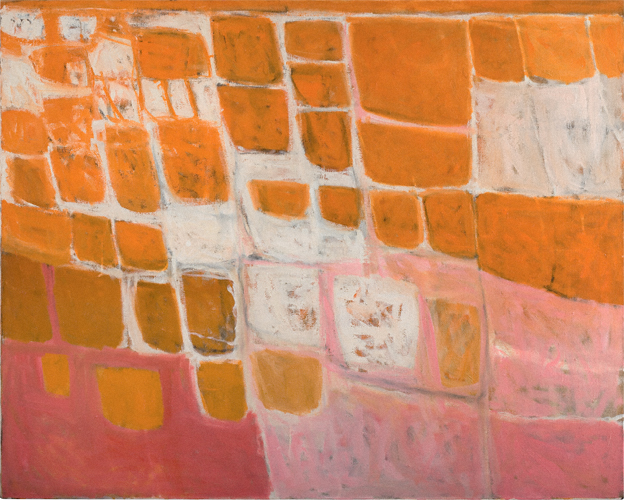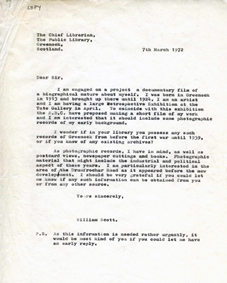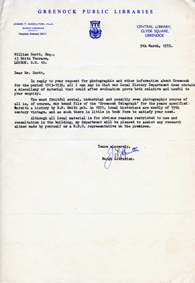William Scott’s Memories of Greenock

William Scott was born on 15 February 1913 in Greenock, Scotland (if he were still alive, he would have turned 102 yesterday!). Robert and James Scott, William’s sons, felt that it was only fitting that the William Scott Foundation donate a painting by their father to the McLean Museum and Art Gallery in Greenock, in recognition of their father’s ties to the place of his birth (until now, the only work by Scott in the McLean Museum’s collection was a print donated by the Scottish Arts Council). The painting, which was given to the museum today, belongs to a series of ‘Breton Landscapes’ painted in either 1938 or 1939 when Scott was living in Brittany. Although the landscape is of France, the plain, white houses bring to mind the Celtic crofter’s cottages with which Scott was familiar from his childhood days in Scotland and Ireland.
This donation prompted us to search through the William Scott Archive for any material related to Scott’s childhood in Greenock. What we found was… very little! There are photographs which record Scott’s early years in Enniskillen (where he lived from 1924 to 1928) and even documentation about artworks he produced there, but there are very few references to be found to the Greenock years. What there is, however, is quite revealing.
In 1972, a short documentary film on Scott, produced by the Arts Council, was recorded for the BBC. From a file of papers found in the William Scott Archive, it is clear that Scott was personally involved in the project from the beginning. A variety of notes – from vague ideas scribbled on a piece of paper to fully thought through typed recollections – it is clear that Scott saw his formative years as crucial to the development of his artistic identity. On one sheet of paper, alongside Scott’s written evocations of Greenock, is a sketch of the quay with the industrial buildings behind and, behind this, the curved outline of the hilltops. It does much to support Scott’s theory; the scenery of his childhood is translated into a near abstract drawing in which objects are depicted using the most minimal of means. Apparent too is that, even at the time of the 1972 film, Scott had no photographic records of Greenock. In March 1972 he wrote to the Chief Librarian of the Greenock Public Library to ask if they had any images from photographs, postcards, newspaper cuttings or books dating from the pre-war years. Fortunately for Scott, and the film makers, they did (Scott received a reply only two days after his letter was sent).
Although many of the notes are brief, there is one typed manuscript in which Scott described at length his memories of Greenock; a highly descriptive piece of writing, it provides a fascinating insight into Scott’s early childhood:
‘I was born in 1913 in Tobago Street, Greenock. My father was from Ulster, a painter and decorator and sign writer by trade, and I was third of a large family. The street I lived in was the last street at the top of the Bray, you could see the tall granite tenements from the quay and behind the tenements were the Whin hills and the moors. At the quay sugar was loaded from the ships onto carts and horses, and pulled by trace horses up the hills to the sugar refineries at the end of our street. The streets were cobbled and in the middle of the streets there was a lot of horse dung. Greenock was built on a long narrow stretch on the edge of the Clyde on sloping hills and three different railway lines ran parallel through the town. There were a lot of bridges, tunnels, stations and steps, stone bridges that you went over and iron bridges that you went under. Bits of ground between streets that had never been built on, growing nettles and the summer littered with small pieces of dirty paper. With my father and mother and seven brothers and sisters, we had to fit into a small flat at the top of our granite block, three rooms with beds built into walls, a sink, two cupboards and a kitchen range. A lavatory on the landing shared with two other flats with as many children as we had. … A feature of Greenock I remember at this time was a variety of noises. There were noises from the ships letting us know that they were anchoring and calling for the tug-boats that would take them up the Clyde to Glasgow. Whistles from the factories punctuated our lives and the steam engines puffed their way under the bridges. The coalmen called “charcoal briquettes”, and the Italian ice-cream men rang bells, the oil and dry stick men blew bugles and the street singers in the back greens sang as loudly as they could.’
If you have any information about Greenock relevant to the period 1913–1924, or about William Scott in general, we would love to hear from you.
For more information contact:
Lucy Inglis – lucy.inglis@williamscott.org



